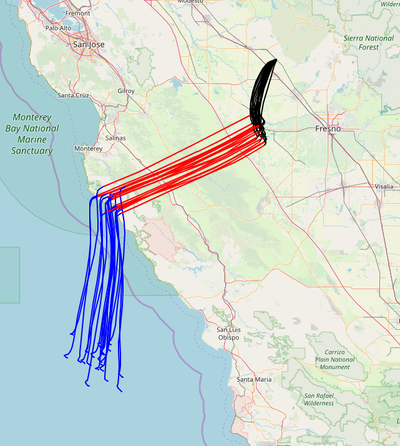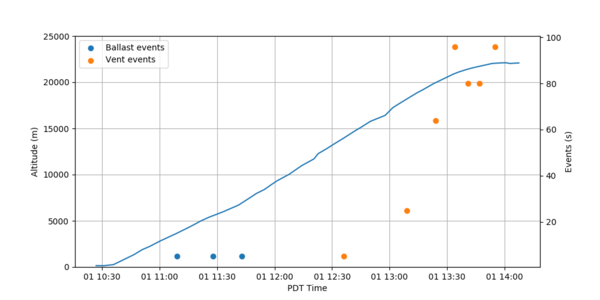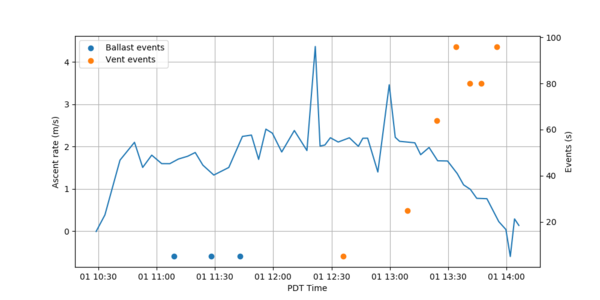Difference between revisions of "SSI-87"
| (9 intermediate revisions by the same user not shown) | |||
| Line 3: | Line 3: | ||
| img link = | | img link = | ||
| designations = '''CY-3''' | | designations = '''CY-3''' | ||
| − | | launch date =June 1, 2019, 10: | + | | launch date =June 1, 2019, 10:35 PDT |
| launch site = Le Grand Elementary School, Le Grand, CA | | launch site = Le Grand Elementary School, Le Grand, CA | ||
| launch coordinates = 37.226, -120.251 | | launch coordinates = 37.226, -120.251 | ||
| − | | flight duration = | + | | flight duration = 3h:52m |
| − | | flight length = | + | | flight length = unknown |
| flight profile = Ballast and vent control | | flight profile = Ballast and vent control | ||
| − | | landing time = | + | | landing time =June 1, 2019, 14:27 ODT |
| − | | landing site= | + | | landing site= 13 km SW of Mendota, Fresno County, CA |
| − | | landing coordinates = | + | | landing coordinates = 36.692, -120.518 |
| − | | last = | + | | last = 86 |
| next = 90 | | next = 90 | ||
}} | }} | ||
'''SSI-87''' (project designation '''CY-3''') was the third launch of [[Cycloon|Project Cycloon]] on June 1, 2019. It featured a legacy ballast and vent mechanism from ValBal operated by Cycloon avionics and was the first such fully controlled Cycloon flight. The mission was noted for its eventful manual equilibration, early termination, and for being the last latex Cycloon before the project transitioned to polyethylene. The payload was recovered the afternoon of the launch. | '''SSI-87''' (project designation '''CY-3''') was the third launch of [[Cycloon|Project Cycloon]] on June 1, 2019. It featured a legacy ballast and vent mechanism from ValBal operated by Cycloon avionics and was the first such fully controlled Cycloon flight. The mission was noted for its eventful manual equilibration, early termination, and for being the last latex Cycloon before the project transitioned to polyethylene. The payload was recovered the afternoon of the launch. | ||
| − | |||
| − | |||
==Project context== | ==Project context== | ||
| Line 24: | Line 22: | ||
Before and around the time of the previous flight, CY-2, a reevaluation of project goals for the quarter had been underway. While a full apex vent equipped flight had originally been envisioned for the weekend of '''June 2''', delays on the project prompted a decision to focus more on quick iterations and numerous launches rather than awaiting longer term initiatives. In particular, it was decided that a legacy ValBal vent mechanism, while unlikely to suffice as a long-term solution, was sufficient and necessary for building altitude control expertise within Cycloon in the short term. Therefore, on '''May 19''', the day after CY-2, it was decided that two payloads would be launched on '''June 1''', alongside Spaceshot and onboarding, each with ballast, vent, and (winds permitting) tether and floater mechanism. | Before and around the time of the previous flight, CY-2, a reevaluation of project goals for the quarter had been underway. While a full apex vent equipped flight had originally been envisioned for the weekend of '''June 2''', delays on the project prompted a decision to focus more on quick iterations and numerous launches rather than awaiting longer term initiatives. In particular, it was decided that a legacy ValBal vent mechanism, while unlikely to suffice as a long-term solution, was sufficient and necessary for building altitude control expertise within Cycloon in the short term. Therefore, on '''May 19''', the day after CY-2, it was decided that two payloads would be launched on '''June 1''', alongside Spaceshot and onboarding, each with ballast, vent, and (winds permitting) tether and floater mechanism. | ||
| − | The bulk of the avionics work for the two payloads | + | The bulk of the avionics work for the two payloads was completed on May 27, followed by demonstration of vent control on May 29. As winds forecasts for favorable for a float-drop profile, a floater was confirmed for the final configuration. The bulk of the mechanics work occurred on May 29, though due to a lack of spare mechanics the second payload was cancelled. Finally, substantial system integration occurred on May 31. It was hoped that the flight would land safely in the Pacific, enabling controlled daytime hops throughout the following week. |
==Configuration== | ==Configuration== | ||
| + | |||
| + | '''Balloon:''' Kaymont 1500g latex. | ||
| + | |||
| + | '''Mechanics:''' ValBal-style cylindrical polycarbonate sheeting, ValBal ballast and vent mechanism. Parachute in parachute tube. Total payload mass (without ballast, tether or floater) 1.07 kg. | ||
| + | |||
| + | '''Ballast:''' 1.5 kg. | ||
| + | |||
| + | '''Tether and floater:''' 30m paracord tether from balloon to payload and 30m paracord tether from balloon to floater. Total tether mass: 0.34kg. Hydrodynamic floater of mass 0.785 kg. | ||
| + | |||
| + | '''Avionics:''' BMP280, TinyGPS, Teensy 3.2 reporting all data at modifiable intervals via RockBlock modem. Ballast motor controlled by N-type MOSFET. Vent motor controlled by breakout motor driver. | ||
| + | |||
| + | '''Power:''' 18 L91 lithium AA batteries. | ||
| + | |||
| + | '''Mass budget:''' Total mass under balloon 3.695 kg. Total mass 5.195 kg. Target fill to 1.4 kg of tension at top of tether, translating to 275 kg free lift. | ||
==Flight synopsis== | ==Flight synopsis== | ||
| + | [[File:Ssi87pred.png|400px|thumb|Predicted flight trajectories before launch]] | ||
| + | |||
| + | |||
| + | '''June 1, 2019, 1035 PDT:''' Launch. A fitting between the neck of the balloon and the vent had to be improvised on site. The target ascent rate was 1.7 - 2 m/s, and the flight plan was to equilibrate at 19-22km, with the first vents occurring at 14km. | ||
| + | |||
| + | '''June 1, 2019, 1109 PDT:''' Due to slow ascent of 1.4 - 1.8 m/s, a first ballast command of five seconds was sent. Balloon altitude was around 3.6 km. | ||
| + | |||
| + | '''June 1, 2019, 1143 PDT:''' Further 5 seconds of ballast were sent, titrating successfully at 1.7 - 2.2 m/s at around 7 km in altitude. | ||
| + | |||
| + | '''June 1, 2019, 1236 PDT:''' First vent command of 5 seconds at an altitude of 13.9 km. | ||
| + | |||
| + | '''June 1, 2019, 1259 PDT:''' A communications gap was noted due to issues with HABMC. For the remainder of the flight, monitoring was performed through the RockBlock website. | ||
| + | |||
| + | '''June 1, 2019, 1309 PDT:''' In response to consistent ascent, a total of 25 seconds of vent were sent at an altitude of 17.8 km. | ||
| + | |||
| + | '''June 1, 2019, 1324 PDT:''' With ascent still maintaining around 2 m/s at nearly 20km, a total of 64 seconds of vent was sent. | ||
| + | |||
| + | '''June 1, 2019, 1334 PDT:''' With ascent only barely below 2 m/s and altitude nearing 21 km, 96 seconds of vent were sent. | ||
| + | |||
| + | '''June 1, 2019, 1341 PDT:''' 80 seconds of vent were sent, successfully slowing ascent to around 0.8 m/s at around 21.5 km. | ||
| + | |||
| + | '''June 1, 2019, 1347 PDT:''' 80 more seconds were sent with the intention of stopping ascent entirely. Altitude approaching 22 km. | ||
| + | |||
| + | '''June 1, 2019, 1355 PDT:''' To play it safe, yet 96 more seconds were sent, as the balloon was nearing the danger zone. Following this, a slight descent was observed after a peak altitude of 22.100 km, and equilibration was declared. | ||
| + | |||
| + | '''June 1, 2019, 1409 PDT:''' It was noticed that the GPS coordinates and altitude had frozen at the launch site. The cause for this remains unknown, and hence no detailed trajectory of this flight is available. Simultaneously, the barometer began reporting a negative altitude. This is when the balloon probably popped, after spending only three communication intervals between 22.0 and 22.1 km. | ||
| + | |||
| + | '''June 1, 2019, 1427 PDT:''' Iridium triangulation began reporting consistent coordinates. It is believed that this was payload impact. | ||
| + | '''June 1, 2019, 1435 PDT:''' GPS began reporting coordinates of landing site. It remains unknown why this reset occurred. A recovery team was dispatched to the landing site. | ||
| + | [[File:Ssi87profile.png|thumb|center|600px|Flight profile from launch to loss of telemetry]] | ||
| + | [[File:Ssi87Rates.png|thumb|center|600px|Ascent rate profile from launch to loss of telemetry]] | ||
{{balloon-footer}} | {{balloon-footer}} | ||
[[Category: High Altitude Balloons]][[Category: Balloon Launches]] | [[Category: High Altitude Balloons]][[Category: Balloon Launches]] | ||
Latest revision as of 10:11, 21 October 2019
| SSI-87 | ||||
|---|---|---|---|---|
| Designations | CY-3 | |||
| Launch date | June 1, 2019, 10:35 PDT | |||
| Launch site | Le Grand Elementary School, Le Grand, CA | |||
| Launch coordinates | 37.226, -120.251 | |||
| Flight duration | 3h:52m | |||
| Flight length | unknown | |||
| Flight profile | Ballast and vent control | |||
| Landing time | June 1, 2019, 14:27 ODT | |||
| Landing site | 13 km SW of Mendota, Fresno County, CA | |||
| Landing coordinates | 36.692, -120.518 | |||
| ||||
SSI-87 (project designation CY-3) was the third launch of Project Cycloon on June 1, 2019. It featured a legacy ballast and vent mechanism from ValBal operated by Cycloon avionics and was the first such fully controlled Cycloon flight. The mission was noted for its eventful manual equilibration, early termination, and for being the last latex Cycloon before the project transitioned to polyethylene. The payload was recovered the afternoon of the launch.
Project context
Before and around the time of the previous flight, CY-2, a reevaluation of project goals for the quarter had been underway. While a full apex vent equipped flight had originally been envisioned for the weekend of June 2, delays on the project prompted a decision to focus more on quick iterations and numerous launches rather than awaiting longer term initiatives. In particular, it was decided that a legacy ValBal vent mechanism, while unlikely to suffice as a long-term solution, was sufficient and necessary for building altitude control expertise within Cycloon in the short term. Therefore, on May 19, the day after CY-2, it was decided that two payloads would be launched on June 1, alongside Spaceshot and onboarding, each with ballast, vent, and (winds permitting) tether and floater mechanism.
The bulk of the avionics work for the two payloads was completed on May 27, followed by demonstration of vent control on May 29. As winds forecasts for favorable for a float-drop profile, a floater was confirmed for the final configuration. The bulk of the mechanics work occurred on May 29, though due to a lack of spare mechanics the second payload was cancelled. Finally, substantial system integration occurred on May 31. It was hoped that the flight would land safely in the Pacific, enabling controlled daytime hops throughout the following week.
Configuration
Balloon: Kaymont 1500g latex.
Mechanics: ValBal-style cylindrical polycarbonate sheeting, ValBal ballast and vent mechanism. Parachute in parachute tube. Total payload mass (without ballast, tether or floater) 1.07 kg.
Ballast: 1.5 kg.
Tether and floater: 30m paracord tether from balloon to payload and 30m paracord tether from balloon to floater. Total tether mass: 0.34kg. Hydrodynamic floater of mass 0.785 kg.
Avionics: BMP280, TinyGPS, Teensy 3.2 reporting all data at modifiable intervals via RockBlock modem. Ballast motor controlled by N-type MOSFET. Vent motor controlled by breakout motor driver.
Power: 18 L91 lithium AA batteries.
Mass budget: Total mass under balloon 3.695 kg. Total mass 5.195 kg. Target fill to 1.4 kg of tension at top of tether, translating to 275 kg free lift.
Flight synopsis
June 1, 2019, 1035 PDT: Launch. A fitting between the neck of the balloon and the vent had to be improvised on site. The target ascent rate was 1.7 - 2 m/s, and the flight plan was to equilibrate at 19-22km, with the first vents occurring at 14km.
June 1, 2019, 1109 PDT: Due to slow ascent of 1.4 - 1.8 m/s, a first ballast command of five seconds was sent. Balloon altitude was around 3.6 km.
June 1, 2019, 1143 PDT: Further 5 seconds of ballast were sent, titrating successfully at 1.7 - 2.2 m/s at around 7 km in altitude.
June 1, 2019, 1236 PDT: First vent command of 5 seconds at an altitude of 13.9 km.
June 1, 2019, 1259 PDT: A communications gap was noted due to issues with HABMC. For the remainder of the flight, monitoring was performed through the RockBlock website.
June 1, 2019, 1309 PDT: In response to consistent ascent, a total of 25 seconds of vent were sent at an altitude of 17.8 km.
June 1, 2019, 1324 PDT: With ascent still maintaining around 2 m/s at nearly 20km, a total of 64 seconds of vent was sent.
June 1, 2019, 1334 PDT: With ascent only barely below 2 m/s and altitude nearing 21 km, 96 seconds of vent were sent.
June 1, 2019, 1341 PDT: 80 seconds of vent were sent, successfully slowing ascent to around 0.8 m/s at around 21.5 km.
June 1, 2019, 1347 PDT: 80 more seconds were sent with the intention of stopping ascent entirely. Altitude approaching 22 km.
June 1, 2019, 1355 PDT: To play it safe, yet 96 more seconds were sent, as the balloon was nearing the danger zone. Following this, a slight descent was observed after a peak altitude of 22.100 km, and equilibration was declared.
June 1, 2019, 1409 PDT: It was noticed that the GPS coordinates and altitude had frozen at the launch site. The cause for this remains unknown, and hence no detailed trajectory of this flight is available. Simultaneously, the barometer began reporting a negative altitude. This is when the balloon probably popped, after spending only three communication intervals between 22.0 and 22.1 km.
June 1, 2019, 1427 PDT: Iridium triangulation began reporting consistent coordinates. It is believed that this was payload impact.
June 1, 2019, 1435 PDT: GPS began reporting coordinates of landing site. It remains unknown why this reset occurred. A recovery team was dispatched to the landing site.
| Balloon Launches | |
|---|---|
| 2014-15 | SSI-19 • 20 • 21 • 22 |
| 2015-16 | SSI-23(a) • 24 • 25 • 26 • 27 • 28 • 29 • 30 • 31 • 32 • 33 • 34 • 35 • 36 • 37 • 38 • 39 • 40 • 41 • 42 • 43 |
| 2016-17 | 44 • 45 • 46 • 47 • 48 • 49 • 50 • 51 • 52 |
| 2017-18 | |
| 2018-19 | 83 • 86 • 87 • 90 • 91 |
| 2019-20 | 92 • 93 • 97 |
| V • E | |


